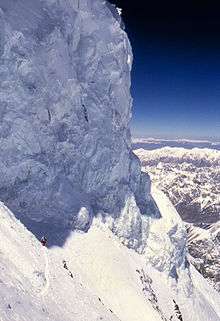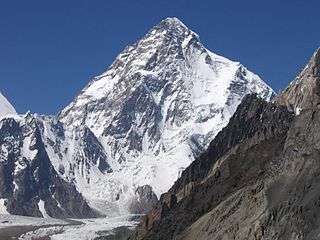Bottleneck (K2)

The Bottleneck is a location along the South-East Spur, known also as Abruzzi Spur— the most used route to the summit of K2, the second-highest mountain in the world, in the Karakoram, on the border of Pakistan and China.
The Bottleneck is a narrow couloir, which is overhung by seracs from the ice field east of the summit. The couloir is located only 400m below the summit, and climbers have to traverse about 100m exposed to the seracs to pass it. Due to the height (8200m) and the steepness (50-60 degrees) this stretch is the most dangerous part of the route.[1] According to AdventureStats, 13 out of the last 14 fatalities on K2 have occurred at or near the Bottleneck.[2]
Despite all the dangers, the Bottleneck is still technically the easiest and the fastest route to the summit. Most climbers choose to use it to minimize time required to spend above 8,000 metres (the "death zone"). The standard route, the Abruzzi Spur (SE), as well as the Cesen route (SSE Ridge, which joins SE Ridge), and the American variety on the NE Ridge (traverse across E Face to SE Ridge), all attain the summit via the Bottleneck.
The climbers approaching the bottleneck start from a shoulder, on almost level ground just below 8,000 metres, where typically the highest camp is located. The bottom end of the couloir drops to the south face of the mountain, and it gradually steepens to 60 degrees just below the ice field. It is not possible to climb up the icefield, which rises straight up tens of metres, but one has to traverse leftwards at the bottom of the icefield 100 metres until it is possible to pass the icefield.
It is possible to bypass the Bottleneck by rock-climbing the cliffs on the left. However, due to the technical difficulty of this approach, it has only been done once, by Fritz Wiessner and Pasang Dawa Lama Sherpa in 1939.
On August 4, 2009, Dave Watson became the first person to ski down the Bottleneck.[3]
See also
References
- ↑ K2climb.net, The climb from the Pakistan side
- ↑ K2 fatalities adventurestats.com. Retrieved 18 October 2011.
- ↑ K2 Ski Expedition 2009

